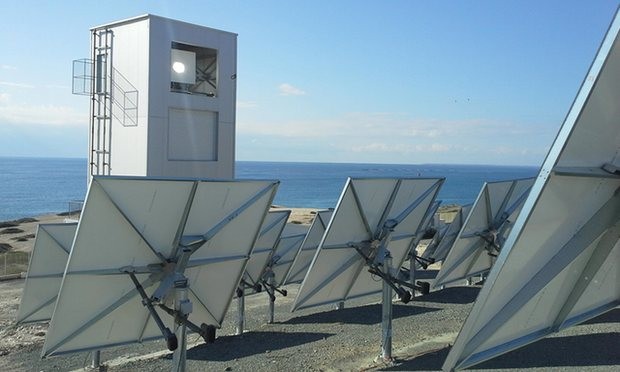Cyprus pins hopes on Australian solar technology to make shift away from oil

Scientists from CSIRO (Australia’s national science agency) have designed and installed a solar field in Cyprus which places the island nation at the frontier of solar energy research in Europe. The solar thermal field lies in Pentakomo, on the southern coast of Cyprus.
Australian scientists have designed and installed solar energy technology in Cyprus to help the island nation shift away from fossil fuels and also tackle its chronic water shortages.
A team from the CSIRO took five weeks to construct a “solar thermal field” containing 50 heliostats – large mirrors that reflect the power of the sun – at Pentakomo, located in the south of Cyprus.
The CSIRO won an international tender to provide its technology to Cyprus for a trial that could lead to broad solar take-up in the country and elsewhere. It is understood that several other countries in Europe and the Middle East are interested in adopting CSIRO solar technology.
Cyprus hopes to take on the technology so it can reform its oil-dependent economy and meet a European Union target of 13% of energy coming from renewable sources by 2020. The Mediterranean country is also plagued by water shortages and may use solar energy to power desalination plants.
The CSIRO technology uses mirrors to track the sun and reflect it towards a single receiving point on top of a tower. This heat then warms a fluid, in this case molten salt.
The molten salt, heated to 250C, is stored in a hot tank and the steam produced powers a turbine for electricity. Crucially, this storage method allows for energy to be produced long after the sun has disappeared.
“The question about solar is always about storage at night-time,” said Wes Stein, solar research leader at CSIRO. “This liquid is cheaper and more efficient than batteries, such as those made by Elon Musk. We can generate steam for electricity on a cloudy day.
“This is Cyprus’ first foray into real solar infrastructure and hopefully it’s replicated across the country. They are close to countries such as the UAE and Saudi Arabia who could translate this technology as well.”
The Cyprus project provided $500,000 for the CSIRO but Stein said the returns could be in the “tens of millions” if other countries licensed the technology for larger scale developments.
Stein added that Australia could theoretically provide all of its electricity via solar energy in this way, requiring a site measuring 50km by 50km, a third of it taken up by mirrors.
CSIRO built the first version of the heliostats in 2006 and hopes to license its technology to manufacturers around the world. The science agency believes its heliostats are superior to those used elsewhere because their smaller mirrors provide a higher control over the reflected sunlight, while the infrastructure requires just two people to install it.
An experimental heliostat facility in Newcastle, New South Wales, has 450 mirrors. But opportunities for deployment across Australia have been stymied over the past 12 months amid a quest by the federal government to slash Australia’s renewable energy target.
Investment in large-scale renewable energy in Australia has slumped 90% in the past year, according to Bloomberg New Energy Finance.
Just one large-scale renewables project, worth $6.6m, has been financed this year, due to uncertainty caused by political negotiations over the RET’s future. More than 2,300 jobs in the renewable energy sector have been lost in the past two years, Australian Bureau of Statistics figures show.
“Hopefully there will be an opportunity to use heliostats in Australian projects,” said Stein.
“Australia has the best solar radiation of any continent in the world and we are looking for opportunities to deploy this technology here as well as overseas.”
According to the Australian Energy Market Operator, building a 100% renewable energy system would cost the nation between $219 billion to $332 billion, depending upon the scenario.
Proponents of a complete switch to renewable energy argue that this level of investment, over a 35-year period as coal is phased out, is reasonable and similar to current levels of spending upon fossil fuel development.
Your message has been submitted successfully.

